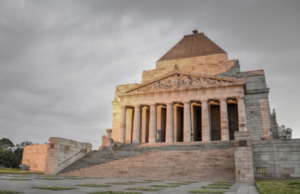An iconic Melbourne attraction, the Shrine of Remembrance is a war memorial located in Kings Domain on St Kilda Road.
Melbourne’s Shrine of Remembrance was originally build to honour the men and woman of Victoria who served in World War 1. However, it now functions as a memorial to all Australians whom have served in any war. It is one of the largest war memorials in Australia, and a site for annual observances for Anzac Day (25 April) and Remembrance Day (11 November).
About Melbourne’s Shrine of Remembrance
Architecture and design
The Shrine was designed by World War l veterans Philip Hudson and James Wardrop. It was built in a classical style, based on the Tomb of Mausoleum at Halicarnassus and the Parthenon in Athens, Greece. The top of the Shrine references to the Choragic Monument of Lysicrates. The building is built with Tynong granite.
Originally the Shrine only consisted of the Central Sanctuary surrounded by the ambulatory. You can find the marble stone of remembrance in the building, which has the words “Greater love hath no man’ engraved in it. Once per year, on Remembrance Day 11 November at 11a.m., to be precise, a ray of sunshine shines through an aperture in the roof to light up the word “love” in the inscription.
Beneath the sanctuary lies the crypt. Which contains a bronze statue of a soldier father and son, together with panels listing every unit of the Australian Imperial Force.
History
1918-1922
A war memorial was proposed directly after the war ended in November 1918. The War Memorials Advisory Committee was selected by the Victorian state government in the early 1920s. The committee was chaired by Sir Baldwin Spencer. He recommended an “arch of victory” over St Kilda road, the boulevard leading out of the city of Melbourne to the south.
An executive committee was formed in late 1921. The former commander of the Australian Forces in the war, General Sir John Monash, was its driving force. The committee soon proposed a large monumental memorial to the east of St Kilda road. This position would make the monument clearly visible from the city centre.
In March 1922, a competition was held to find a design for the new memorial. This competition was also open to any Australian citizens who were residing oversees and British subjects residing in Australia. 83 entries were submitted for the competition and in December 1923 Phillip Hudson and James Wardrop won the competition.
1922-1927
The winning proposal had a number of supporters, such as Georges Taylor’s Sydney based trade journal and artist Norman Lindsay. However, the design was also fiercely criticised by Keith Murdoch’s Herald saying it was “too severe, stiff and heavy”.
Movements were held against the building of the shrine. These movements were looking for substitute concepts, arguing that the funds could be spend better on a more practical project such as a hospital. Furthermore, some Christian churches also did not agree with the design, since it has no cross or Christian component.
The new Victorian Labour government (1924), under George Prendergast, supported Heralds view, and pushed for a memorial hospital instead. The plans changed again, when the labour government was replaced with John Allen’s National coalition. This time they leaned more in the direction of the earlier suggestion of an arch of victory.
Significant delays postponed the building of the new memorial this resulted in a temporary wood-and-plaster cenotaph for the 1926 Anzac Day march. The success of the momentary cenotaph resulted in the Victorian government deserting the earlier project in 1926, and propose a permanent cenotaph instead in a large ANZAC square at the top of Bourke St in front of Parliament House.
This plan involved the destroying of the Windsor Hotel, one of Melbourne’s favourite hotels. The new strategy won the support of the Herald, the Returned Soldiers League (RSL) and the Melbourne City Counsel. Nevertheless, Monash and Legacy still supported the shrine. When a vote was called for the majority of the public voted in favour for the Shrine.
1927-1934
On 11 November 1927, the foundation stone was laid, by the governor of Victoria, Lord Somers. Both the Victorian and commonwealth governments made donations, however most of the costs were raised in less than six months by communal contributions, with Monash as the leading fundraiser.
Monash, took personal charge of the construction, because he was also an engineer. The construction started in 1928 and was handled by contractors Vaughan & Lodge. Monash died (1928) before the Shrine was finished.
Work was eventually finished in September 1934. The shrine was formally devoted on the 11th of November, by the Duke of Gloucester, witnessed by a crowd of over 300,000 people, one of the biggest crowds that Melbourne has ever seen. During World War ll, the Shrine was used as an air raid shelter and zig-zag trenches were dug on the grounds on protect civilian from bomb blasts.
1945-1985
It was vital to add an additional element to the shrine after World War ll. Another competition was held, with A.S Fall and E.E. Milston as the dual winners. Miltons design was eventually chosen. The result was the World War ll forecourt, a broad expanse of stone in front of the shrine’s north face; the Eternal Flame, an everlasting gas flame set just to the west of north face; and the World War ll memorial, a 12.5-meter-high memorial a little further west.
Australia’s involvements in later wars, such as the Vietnam War, Korean War and the Gulf War, are memorialised by engravings. The Remembrance garden was added underneath the western face of the Shrine to honour those who served throughout the post-World War ll conflicts.
The Shrine became a centre of conflict throughout the Vietnam War. Anti-war demonstrators protested during ANZAC Day services against Australia’s participation in the war. The shrine was vandalised in 1971, when the word ‘peace!’ was painted in huge white letters on the pillars of the north portico.
2002-present
During the 1990s, restoration works raised the possibility of taking advantage of the space underneath the Shrine; the shrine had been built on a hollow artificial hill and the under croft provided a large space for expansion. The new construction was supposed to provide a visitors centre, administration facilities and an improved access to the Shrine’s crypt, as many of the veterans found the stairs difficult to climb.
Special thoughtfulness was given to the entrance when the renovation started. The first plan was to create a tunnel from the east. This was however discarded as it had “no sense of ceremony”. As a substitute, it was decided to develop two new courtyards, and place the new gallery under the northern steps.
Constructions started in 2002, with the design by architect Ashton Raggat McDougall, and the new areas were opened in August 2003. The Victorian Architecture Medal was awarded to the completed project, by the Royal Australian Institute of Architects in 2004.
There were still more requests to further develop the site, after the construction was compete. This was mainly about providing facilities for education about the wars. A proposal was presented in 2006, incorporating a museum and an underground carpark. Ashton Raggat McDougall designed this once again.
The proposal was opposed by local residents and some council members. It then ran into funding problem when the Federal government decided not to provide funding. The Victorian government announced that $22.5 million would be allocated to develop the shrines under croft and extend it to the south. The new exhibition space, was opened on Remembrance Day in 2014.
Join us on a Go West Tour to learn more about the history and attractions of Melbourne!
Written by Jessica Senden – Marketing Intern @gowest.com.au




